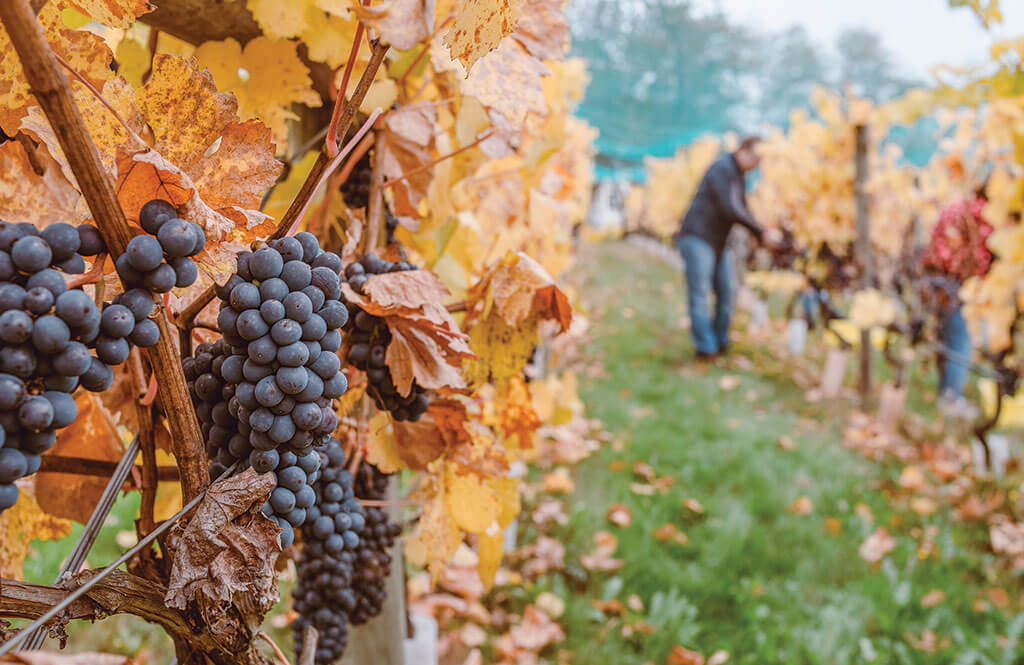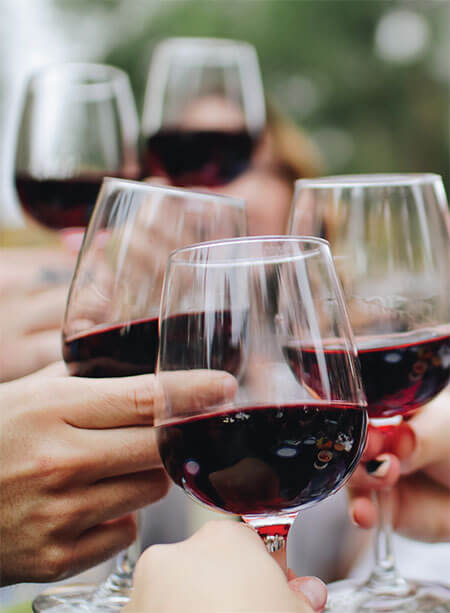

The vineyards of the Hudson Valley are among the busiest of places in the fall, as the grapes ripen for picking and the winemaking process
Fall harvest is a busy time in the Hudson Valley. Leaves are changing color and the last fruits of the season are ripening. There’s a lot to be done before the quiet of the barren winter cold sets in, and vineyards of the Hudson Valley are among the busiest of places as the grapes ripen for picking and the winemaking process begins.
There are many metamorphoses grapes need to go through before they achieve the maturity in which they are picked. Veraison is the beginning, when the grapes begin to change color. The tannins ripen and astringent malic acid begins to give way to softer tartaric acid. Leaves are often pruned at this time to give grapes more sun and wind exposure. The warm days and cool nights are optimum conditions for the grapes to achieve maturation. Vineyards will put netting out over the grapes to protect them from being feasted upon by wildlife such as birds and deer.
Grapes are picked when the sugar content or brix levels are between 21 to 26 degrees. The sugar content of the juice is what will be converted to alcohol during fermentation; this measurement tells the winemaker when the optimal time is to pick the grapes for harvest.
Harvest begins in the valley as early as the second week in September and lasts through the first week in November.
Chardonnay, Seyval, and Pinot Noir are the grapes in the valley that ripen the earliest each year; Merlot and Cabernet Franc are the last ripening grapes to be harvested. In a typical year, harvest begins in the valley as early as the second week in September and lasts through the first week in November.
Grapes in the Hudson Valley are usually handpicked, then brought to the destemmer/crusher. Red wine grapes are run through the destemmer/crusher to remove the fruit from stems with minimal rupture of the grape skins. Whites are typically destemmed and crushed with intentional rupturing of the skins. Then the white wine is pressed and the juice is pumped into steel tanks to begin fermentation. The process of fermentation of red wines and white wines differs: With white wine, the clear juices are typically pumped after pressing into a stainless steel tank to begin fermentation. In the case of barrel-fermented Chardonnay, it is begun in the tank, then fermentation is completed in the barrel.
Red wine processing is different. After destemming, the berries are not separated from the skins or seeds, but go through the process with all elements mixed together. The hearty, robust flavors of red wine come from this togetherness of the juice, seeds, and skins. The fermentation process extracts more tannins, flavors, and color from the skin and seeds.


To begin the fermentation process, yeast is added to the juice. Yeast consumes sugar, which then converts into alcohol and carbon dioxide. It also liberates molecules within the juice, bringing out the flavor of the grape itself.
The grapes may be fermented in oak barrels, bins, or a stainless steel tank. Stainless steel tanks provide stable temperatures and produce crisp, clean white wines. Oak barrels contribute tannins of their own and render a fuller-bodied wine with more complex overtones. White wines are fermented for four to six weeks at about 60˚F, while red wines are fermented between 65 and 80˚ for four to 14 days. After fermentation, if the wine is to be aged in oak, the juice is moved into oak barrels to begin the aging process. Whites are usually bottled in the springtime. Reds can age a few years in the barrel before bottling.
We are so fortunate to have a wide variety of local wines available to us that carry the richness of the Hudson Valley climate and soil. While tastings are not being offered at this time, a weekend drive along the Hudson River to visit some of our fine wineries is a perfect day trip. Pick up a few bottles of local wines that you may not find anywhere else and stock up for the winter, while enjoying the colorful tapestry of fall along the way.
You can plan a visit to our local wineries through www.gunkswine.com

